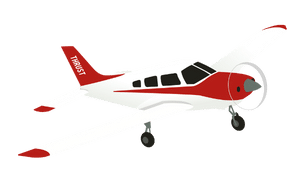In order to work as an airline dispatcher, you must be licensed by the FAA. And the FAA has pretty detailed requirements for who is eligible for a license:
- Be at least 23 years old when you apply for the license
- Be proficient in English
- Graduate from an approved training course consisting of at least 200 hours of training
- Pass both a written and a practical exam
In many respects, this is similar to other FAA licenses, where you are required to attend school, pass a written exam, and obtain your license after completing an FAA checkride or practical test.
As is the case with other FAA licenses, such as pilots and mechanics, the dispatcher exam actually consists of two components: a multiple-choice written exam and a one-on-one oral exam given by a designated examiner.
This might remind you of the days when you went to get your driver’s license.
In most cases, you probably had to pass a written exam to get a learner’s permit, and then come back after some practice for a driving test in a car, where you can show off your skills.
If you’re thinking about becoming a flight dispatcher you’re probably worried about the dispatcher exam. Here’s a look at the details of those tests and how to best prepare for them.
Flight Dispatcher Written Exam
Like all FAA written exams, the dispatcher test is a multiple-choice exam. But don’t let that lull you into complacency — the FAA has an incredible capacity for making multiple-choice tests very effective at determining whether or not you know your stuff!
The ADX exam, as the FAA refers to it, consists of 80 questions, and you have 3.5 hours to complete it. To pass, you must score at least 70%.
Dispatcher tests can be taken at most approved FAA testing centers; however, the location of your dispatcher training course will likely have one (or work with one nearby).
You can download a list of sample questions from the FAA website to get a feel for the types of questions it asks.
Here are three of the examples from that document:
The maximum speed during takeoff that the pilot may abort the takeoff and stop the airplane within the accelerate-stop distance is
A. Vref
B. V1
C. V2
If a four-engine air carrier airplane is dispatched from an airport that is below landing minimums, what is the maximum distance that a departure alternate airport may be located from the departure airport?
A. Not more than 2 hours at normal cruise speed in still air with one engine inoperative.
B. Not more than 2 hours at cruise speed with one engine inoperative.
C. Not more than 1 hour at normal cruise speed in still air with one engine inoperative.
Which feature is associated with the tropopause?
A. Absence of wind and turbulence.
B. Abrupt change of temperature lapse rate.
C. Absolute upper limit of cloud formation.
As you can see, these questions require a solid understanding of the Federal Aviation Regulations (FARs), meteorology, aircraft performance, and a few other topics.
They aren’t necessarily difficult, but to even understand them, you will have to have spent a considerable amount of time studying the materials.
The good news? You won’t just show up unprepared for this exam.
You’ll take the exam after you’ve done the training course, which means you’ll have studied it all thoroughly.
Furthermore, you’ll likely have completed a few practice exams of the same style, so it’ll not be new to you on the day you take your exam.

For extra help, there are test prep software packages that allow you to simulate the exam at home. This will enable you to take as many practice exams as you like until you get it right.
Be warned, however, that the FAA doesn’t publish its entire ever-evolving bank of test questions.
So, no matter how good the software is, it will never be precisely the same as the test. That means you can’t memorize the answers; you must study the material and understand it to succeed on the exam.
Check out our tips to prepare for your FAA written exam.
Flight Dispatcher Practical Exam
The practical test is conducted like an interview, one-on-one with an FAA inspector or a designated examiner.
It’s often referred to as the Oral Exam or the Skills Test.
This is when you have to demonstrate your ability to perform the hands-on tasks required for the job, such as pulling out performance and weather charts and plotting a real flight.
While it may sound intimidating, the fact is that it’s a very structured, almost scripted exam.
The FAA publishes what you must know — and how well you must know it — in a document called the Practical Test Standards (PTS). It’s available for download on the FAA website.
This document is your key to passing the exam successfully.
The opening pages discuss your reference books and the exam’s administration, and then the exam is broken down into Areas of Operation that you will be tested on.
For example, here is the first task you must complete:
Task A: Regulatory Requirements
References: 14 CFR parts 1, 25, 61, 65 subpart C and Appendix A, 71, 91, 121, and 139; 49 CFR parts 175, 830, and 1544; AC 91-70; General Operations Manual; Operations Specifications.
Note: Where appropriate, questions on other Areas of Operation may be based on the assigned flight.
Objective: To determine the applicant:
1. Can explain the regulatory requirements for obtaining an aircraft dispatcher certificate and discuss why air carriers employ dispatchers.
2. Exhibits adequate knowledge of the elements of flight planning and dispatch release(s) by preparing a flight plan, load manifest, takeoff data information, and dispatch release for a flight between designated airports.
3. Is able to plan the flight in accordance with regulatory requirements, operations specifications, and company procedures and provide all required information for that flight to the PIC.
4. Can recognize additional information that may affect the safety of the flight during flight and provide that information to the PIC in a timely manner.
As you can see, it’s very specific in the things you will be tested on, and where that information has come from.
There are many ways to prepare for the oral, but one of the best is to obtain a copy of ASA’s Aircraft Dispatcher Oral Exam Guide.
It’s a small booklet that poses sample questions and provides the answers. After reading through the book yourself, you can hand it to a buddy and have them quiz you.
If you’ve got someone knowledgeable about the job, that’s even better.
The practical exam is the culmination of all of your studying and training, just like your final exam days from school.
You’ll study very hard up to the exam, and you’ll probably want to seek out extra help and tutoring from your instructors to ensure that you’re on the right track. You’ll want to adopt all the best study habits, from using flashcards to practicing skills repeatedly in your free time.
After all that studying, don’t blow it on the last day.
Since it’s a performance test, you need to be at your peak when you show up.
Treat it like an important job interview: Get there early, show up well-rested and prepared, and dress for the job you want.
Be professional and courteous, and answer each question carefully with consideration.

Is the Aircraft Dispatcher Test Difficult?
Now that you have a better idea of what the aircraft dispatcher exams look like, do they seem difficult?
Most people agree that the written, multiple-choice exam resembles what they’re accustomed to from school.
They study for it, maybe they even cram for it, and they get through it. It’s not anything particularly new.
The practical exam, however, is a different beast.
Very few people have experience with one-on-one oral exams like this, so it might be the first time you have to do one. That in itself is intimidating, and many applicants are nervous about it.
It is highly structured, however.
The examiners do not just ask anything they feel like, and you aren’t expected to know everything. You must meet specific safety standards, and the examiners are very good at determining how prepared you are and how safely you can perform the job.
If you study and prepare, you’ll likely do fine.


